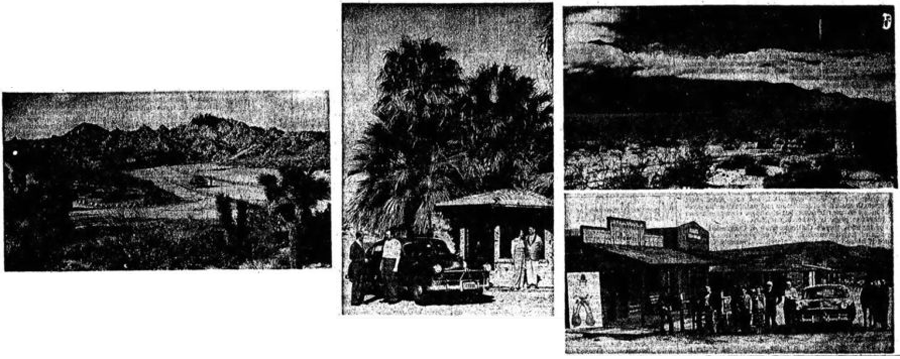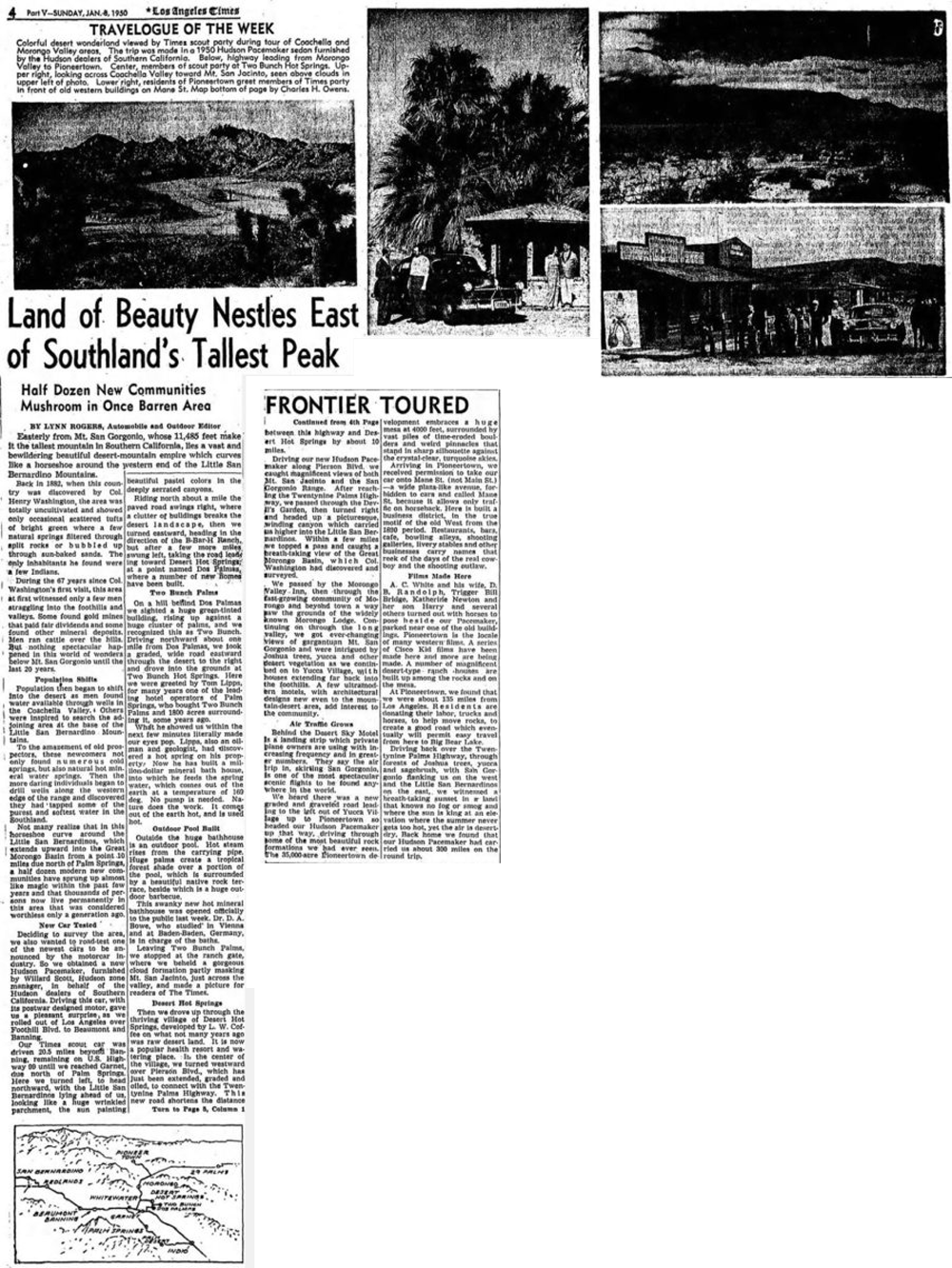Land of Beauty Nestles East of Southland’s Tallest Peak
TRAVELOGUE OF THE WEEK
Half Dozen New Communities Mushroom in Once Barren Area

BY LYNN ROGERS, Automobile and Outdoor Editor
Easterly from Mt. San Gorgonio, whose 11,485 feet make it the tallest mountain in Southern California, lies a vast and bewildering beautiful desert-mountain empire which curves like a horseshoe around the western end of the Little San Bernardino Mountains.
Back in 1882, when this country was discovered by Col. Henry Washington, the area was totally uncultivated and showed only occasional scattered tufts of bright green where a few natural springs filtered through split rocks or bubbled up through sun-baked sands. The only inhabitants he found were a few Indians.
During the 67 years since Col. Washington’s first visit, this area at first witnessed only a few men straggling into the foothills and valleys. Some found gold mines that paid fair dividends and some found other mineral deposits. Men ran cattle over the hills. But nothing spectacular happened in this world of wonders below Mt. San Gorgonio until the last 20 years.
Population Shifts
Population then begin to shift into the desert as men found water available through wells in the Coachella Valley. Others were inspired to search the adjoining area at the base of the Little San Bernardino Mountains.
To the amazement of old prospectors, these newcomers not only found numerous hot mineral springs. Then the more daring individuals began to drill wells along the western edge of the range and discovered they had tapped some of the purest and softest water in the Southland.
Not many realize that in this horseshoe curve around the Little San Bernardino’s, which extend upwards into the Great Morongo Basin from a point 10 miles due north or Palm Springs, a half dozen modern new communities have sprung up almost like magic within the past few years and the thousands of persons now live permanently in this area that was considered worthless only a generation ago.
New Car Tested
Deciding to survey the area, we also wanted to road-test one of the newest cars to be announced by the motorcar industry. So we obtained a new Hudson Pacemaker, furnished by Willard Scott, Hudson zone manger, in behalf of the Hudson dealers of Southern California. Driving this car, with it’s postwar designed motor, gave us a pleasant surprise, as we rolled out of Los Angeles over Foothill Blvd. to Beaumont and Banning.
Our Times scout car was driven 20.5 miles beyond Banning, remaining on US Highway 99 until we reached Garnet, due north of Palm Springs. Here we turned left, to head northward, with the Little San Bernardino’s lying ahead of us, looking like a huge wrinkled parchment, the sun painting beautiful pastel colors in the deeply serrated canyons.
Riding north about a like the paved road swings right, where a clutter of buildings breaks the desert landscape, then we turned eastward, heading in the direction of the B-Bar-H Ranch, out after a few more miles swung left, taking the road leading toward Desert Hot Springs, at a point named Dos Palmas, where a number of new homes have been built.
Two Bunch Palms
On a hill behind Dos Palmas we sighted a huge green-tinted building, rising up against a huge cluster of palms, and we recognized this as Two Bunch. Driving northward about one mile from Dos Palmas, we took a graded wide road eastward through the desert to the right and drove into the grounds at Two Bunch Hot Springs. Here we were greeted by Tom Lipps, for many years one of the leading hotel operators of Palm Springs, who bought Two Bunch Palms and 1800 acres surrounding it, some years ago.
What he showed us within the next few minutes literally made our eyes pop. Lipps, also an oilman and geologist, had discovered a hot spring on his property. Now he has built a million-dollar mineral bath house, into which comes out of the earth at a temperature of 169 deg. No pump is needed. Nature does the worth. It comes out of the earth hot and is used hot.
Outdoor Pool Built
Outside the huge bathhouse is an outdoor pool. Hot steam rises from the carrying pipe. Huge palms create a tropical forest shade over a portion of the pool, which is surrounded by a beautiful native rock terrace, beside which is a huge outdoor barbecue.
This swanky new hot mineral bathhouse was opened officially to the public last week. Dr. D. A. Bowe, who studied in Vienna and at Baden-Baden, Germany, is in charge of the baths.
Leaving Two Bunch alms, we stopped at the ranch gate, where we beheld a gorgeous cloud formation partly masking Mt. San Jacinto, just across the valley, and made a picture for readers of the Times.
Desert Hot Springs
Then we drove up through the thriving village of Desert Hot Springs, developed by L. W. Coffee on what not many years ago was raw desert land. It is now a popular health resort and wearing place. In the center of the village, we turned westward over Pierson Blvd., which has just been extended, graded and oiled, to connect with the Twentynine Palms Highway. This New road shortens the distance betweens this highway and Desert Hot Springs by about 10 miles.
Driving our new Hudson Pacemaker along Pierson Blvd. we caught magnificent views of both Mt. San Jacinto and the San Gorgonio Range. After reaching the Twentynine Palms Highway, we passed through the Devil’s garden, then turned right and headed up a picturesque, winding canyon which carried us higher into the Little San Bernardino’s. Within a few miles we topped a pass and caught a breath-taking view of the Great Morongo Basin, which Col. Washington had discovered and surveyed.
We passed by the Morongo Valley Inn, then through the fast-growing community of Morongo and beyond town a way saw the grounds of the widely known Morongo Lodge. Continuing on through the long valley, we got ever-changing views of the gargantuan Mt. San Gorgonio and were intrigued by Joshua trees, yucca, and other desert vegetation as we continued on to Yucca Valley, with houses extending far back into the foothills. A few ultramodern motels, with architectural designs new even to the mountain-desert area, add interest to the community.
Air Traffic Grows
Behind the Desert Sky Motel is a landing strip which private plane owners are using with increasing frequency and in greater numbers. They say the air trip in, skirting San Gorgonio is one of the most spectacular scenic flights to be found anywhere in the world.
We heard there was a new graded and graveled road leading to the left out of Yucca Village up to Pioneertown so heading our Hudson Pacemaker up that way, driving through some f the most beautiful rock formations we had ever seen. The 35,000-acre Pioneertown development embraces a huge mesa at 4000 feet, surrounded by vast piles of time-eroded boulders and weird pinnacles that stand in sharp silhouette against the crystal-clear, turquoise skies.
Arriving in Pioneertown, we received to take our car onto Mane St. (Not Main St,) – a wide plaza-like avenue, forbidden to cars and called Mane St. because it allows only traffic on horseback. Here is built a business district, in the true motif of the old West from the 1890 period. Restaurants, bars cafe, bowling alleys, shooting galleries, livery stables and other businesses carry name that reek of the days of real cowboy and the shooting outlaw.
Films Made Here
A.C. White and his wife, D.B. Randolph, Trigger Bill Bridges, Katherine Newton and her son Harry and several others turned out with horses to pose beside our pacemaker, parked near one of the old buildings. Pioneertown is the locale of many western films. A series of Cisco Kid films have been made here and more are being made. A number of magnificent desert-type ranch houses are built up among the rocks and on the mesa.
At pioneertown, we found that we were about 135 miles from Los Angeles. Residents are donating their labor, trucks and horses, to help move rocks, to create a good road which eventually will permit easy travel from here to Big Bear Lake.
Driving back over the Twentynine Palms Highway, through forests of Joshua trees, yucca and sagebrush, with San Gorgonio flanking us on the west and the Little San Bernardino’s on the east, we witnessed a breath-taking sunset in a land that knows no fog or smog and where the sun is king at an elevation where the summer never gets too hot, yet the air is desert dry. Back home we found that our Hudson Pacemaker had carried us about 300 miles on the round trip.

